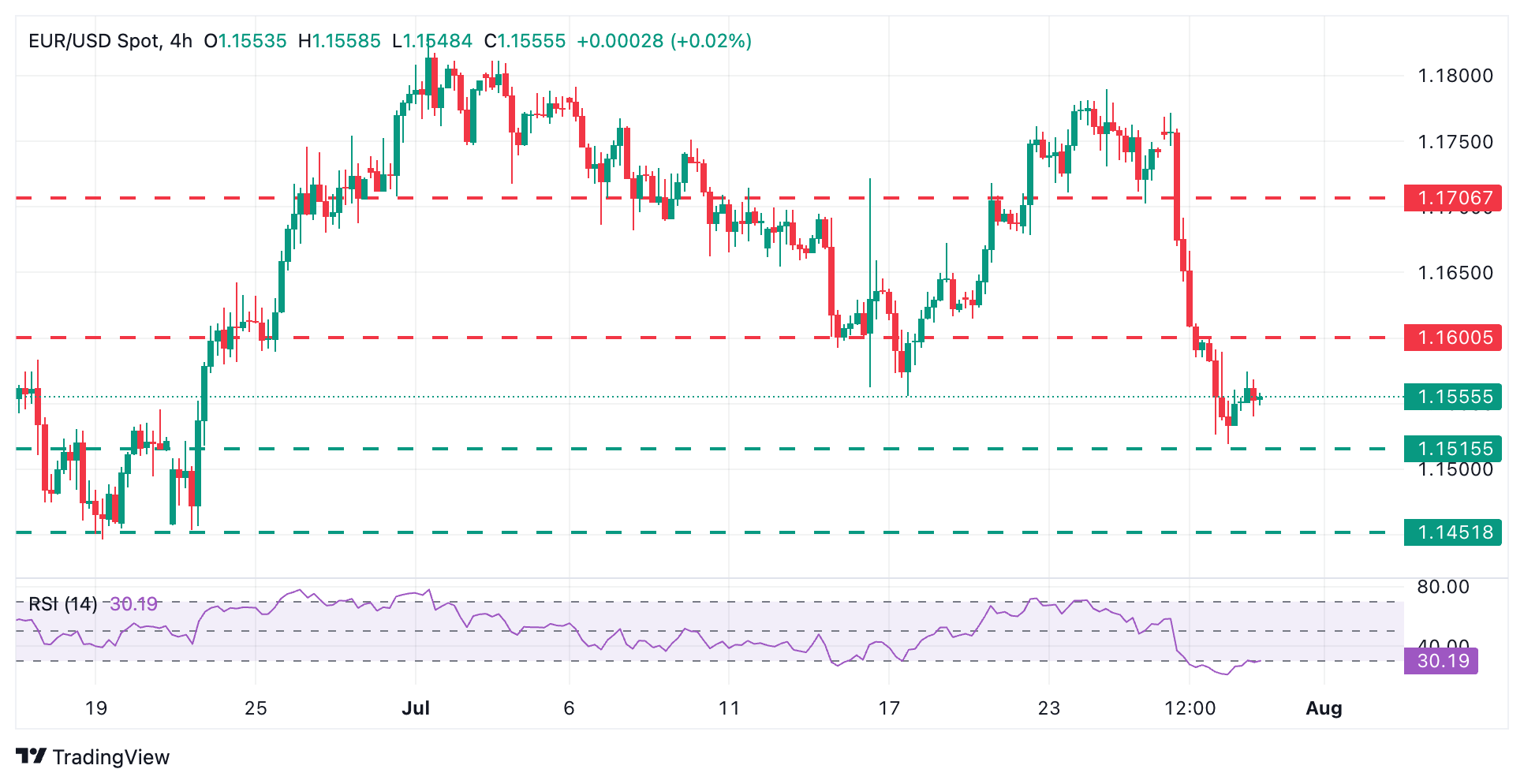- The Euro remains depressed near one-month lows, weighed by concerns about the consequences of the EU-US trade deal.
- The German GDP contracted by 0.1% in the second quarter, in line with economists’ forecasts.
- Forex markets are likely to remain in range ahead of the Federal Reserve’s monetary policy decision.
The EUR/USD pair is wavering near one-month lows and on track for its first monthly decline since December last year. The Euro remains on its back foot, weighed down by the negative reactions to the trade deal between the European Union (EU) and the United States (US).
Investors are also digesting the most recent GDP figures for the second quarter from major European countries, with France growing more than expected and Germany registering a mild contraction. Next, the Eurozone Gross Domestic Product (GDP) figures and the Federal Reserve’s (Fed) interest rate decision are on tap.
The Euro (EUR) posted a mild recovery attempt from five-week lows in Asia, which was capped at 1.1575 before easing to the 1.1550 area during the early European session, practically flat on the day and around 2% below the July 1 highs.
A moderate optimism prevails on Wednesday, with investors awaiting the Fed. The US central bank is widely expected to keep interest rates on hold. The attraction of the event will be Chairman Jerome Powell’s comments to assess any sign of a potential rate cut in the near future.
Wednesday’s monetary policy decision will have a particular transcendence, as it comes after weeks-long unprecedented attacks from US President Donald Trump on the Fed chairman, calling for interest rate cuts, which have raised questions about the independence of the central bank.
In Europe, German Retail Sales data from June have beaten expectations, following a stronger-than-expected economic growth in France. The Euro, however, remains depressed following a trade pact that has been considered far more beneficial for the US than for the European Union, and which has received strong criticism from European capitals.
Euro PRICE Today
The table below shows the percentage change of Euro (EUR) against listed major currencies today. Euro was the strongest against the British Pound.
| USD | EUR | GBP | JPY | CAD | AUD | NZD | CHF | |
|---|---|---|---|---|---|---|---|---|
| USD | -0.02% | -0.01% | -0.21% | 0.02% | 0.04% | -0.09% | -0.06% | |
| EUR | 0.02% | 0.04% | -0.27% | 0.00% | -0.02% | -0.08% | 0.00% | |
| GBP | 0.00% | -0.04% | -0.30% | 0.05% | 0.01% | -0.06% | -0.03% | |
| JPY | 0.21% | 0.27% | 0.30% | 0.30% | 0.32% | 0.19% | 0.22% | |
| CAD | -0.02% | -0.01% | -0.05% | -0.30% | 0.02% | -0.11% | -0.04% | |
| AUD | -0.04% | 0.02% | -0.01% | -0.32% | -0.02% | -0.09% | 0.00% | |
| NZD | 0.09% | 0.08% | 0.06% | -0.19% | 0.11% | 0.09% | 0.06% | |
| CHF | 0.06% | -0.00% | 0.03% | -0.22% | 0.04% | -0.01% | -0.06% |
The heat map shows percentage changes of major currencies against each other. The base currency is picked from the left column, while the quote currency is picked from the top row. For example, if you pick the Euro from the left column and move along the horizontal line to the US Dollar, the percentage change displayed in the box will represent EUR (base)/USD (quote).
Daily digest market movers: The US Dollar remains bid ahead of the Fed
- The US Dollar emerged as the biggest winner in a series of trade deals between the US and its main trading partners. A new round of talks with China held in Stockholm ended without any significant breakthrough, but comments from Trump were positive, which suggests that the trade truce between the world’s two major economies might extend beyond the August 12 deadline.
- Earlier on Wednesday, Destatis data revealed that the German economy contracted by 0.1% in Q2 compared with the previous quarter, as expected. Meanwhile, German Retail Sales increased 1.0% in June, following a 0.6% contraction in May, twice as much as the 0.5% increment forecasted by market analysts.
- Likewise, France’s GDP accelerated to 0.3% in the second quarter against expectations of a steady 0.1% reading. France’s consumer spending also beat expectations in June, with a 0.6% rise, against the 0.1% decline anticipated by the market’s consensus.
- Before the Federal Reserve’s monetary policy decision, due later on the day, the US preliminary GDP is expected to show a 2.4% annualised growth in the second quarter after the 0.5% contraction in the first quarter.
- In the US, on Tuesday, US JOLTS Job Openings declined beyond expectations to 7.43 million from 7.77 million in May, suggesting some cooling in the labour market.
- Also on Tuesday, the Conference Board’s Consumer Confidence Index showed a larger-than-expected improvement, but the survey confirmed that Americans remain wary of the impact of tariffs on their economies. The US Dollar pulled back from its highs after the figures were released.
EUR/USD remains bearish with 1.1450 at a short distance

EUR/USD remains under bearish pressure, with upside attempts finding sellers. The pair might see some recovery, as investors take US Dollar profits ahead of the Fed monetary policy decision, and the 4-hour Relative Strength Index (RSI) comes up from oversold levels after a nearly 2% decline in the previous two days.
Euro bulls have been capped at 1.1575 earlier on Wednesday and are expected to be challenged at Tuesday’s high of 1.1600. A successful break of that level would target 1.1680 (July 22 low) and the 1.1700 area (near July 23 and 25 lows).
To the downside, immediate support is Tuesday’s low of 1.1520 and the 1.1500 psychological level, which closes the path to the June 18,19,
